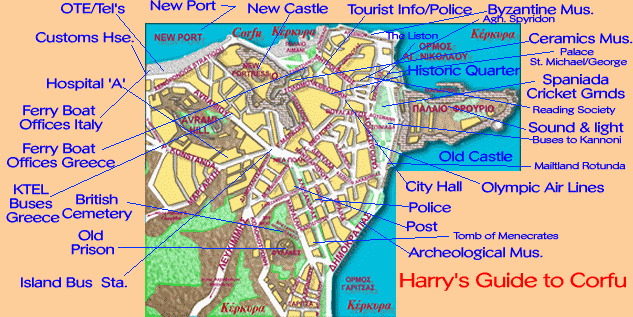 |
Greece Property for Sale - Real Estate In Greece Buy & Sell |
CORFUCorfu Town, pop 41.000, is a charming blend of architectural styles including Venetian, Italian Renaissance, Baroque, Georgian, Neo-classical and traditional island architecture. The flavor is predominately Italianate. The town is dominated by its two Venetian fortresses with a wonderful view obtainable from atop the new fortress from which, on a clear day, Italian, Sicily can be seen. The town's central square is called The Spiniada or Esplanade and joined with Epano Sq. near the old castle and the cricket grounds. Below: waterfront views: architecture and the old castle, The Liston's cafes and Aghion Spyridon church's red dome, the most sacred spot of Corfu.
Facing the Venetian Old Castle stands the statue of General Von Schulenbourg commander of the island's defensive forces which defeated the Turks in 1716. (He was a soldier of fortune from Saxony who through his skill and daring defied the whole power of the sublime portal under the personal command of their lord high admiral during the Great Siege. Thereby frustrating the Turks last great attempt at further conquests of European Christendom. They viewed Corfu as a stepping stone for the rest of Europe.) Other statues on the Esplanade, include the Guilford Memorial in honor of British Philhellene Fredrick North, Earl of Guilford (1769- 1828) and to the south, Count John Capodistrias, Greece's first President who was assasinated by two Cretans for imprisoning their Uncle. Capodistrias was enobled by the Venetians. Corfu Town's houses are closely packed and built six to seven stories high. Its narrow alleys or streets are known as the kandounia and its stone steps as skalinathes. There are several larger mansions of note some of which were built during the second French occupation and some by the British. In the British cemetery, (Garitsa) soldiers memorials share the lovely grounds with wild flowers and orchids in the botanical gardens. Also interred within, are the sailors from the destroyers H.M.S. Saumarez and Volage sunk by Albanian mines in 1946. The Liston was inspired by the Rue de Rivoli in Paris. The name Liston is a contraction of 'List On' because initially, only the islands listed richest citizens and nobility were allowed to promenade there. British architects designed Mon Repos (for Sir Charles Adams, the 2nd Lord High Commissioner (1824-31), and later used by Greece's King George as a summer villa,) and the Palaces of St. Michael and St. George as the residence of King Tom, the first Lord High Commissioner: the unpopular Sir Thomas Maitland.
Above from left: The Maitland Ionic Rotunda, by Sir George Whitmore in the Esplanade, The Palace of St. Michael & St. George with its statue of Sir Charles Adams, and home to the unique in Greece, Museum of Asiatic Art. Lower left, The Liston with its chic and expensive cafes and stores reminiscent of Paris's Rue de Rivloi and insisted upon by Napoleon who also designed the original in Paris. Lower right: the interior of Aghios Spyridon Church wherein lie the remains of the Saint and others. Other significant buildings include the Temple at Paleaopoli (Garitsa), The Ionian Academy, The Church of Aghio Spyridon, The Monastery of Platitera, the Old Prefecture Building, the Latin Arch-Bishops Palace, and The Archeological Museum (Garitsa). The Campiello QuarterBetween The Esplanade and the Old Port, or just North of the Historic Quarter in the map below, you will find worthy architecture of note. These include The Orthodox Cathedral (1576), with its golden icons and dedicated to St. Theodora Augusta, Empress of Byzantium (829-843) who allowed the restoration of icon worship after the destruction of many art works, both contemporary and ancient, due to the zeal of the iconoclasts. Her remains are buried next to Saint Spyridon in St. Spyridon Church along with President Capoditrias' sister who was a nun. The Solomos Museum, (9 am - 1 pm) off Arseniou St. with a collection associated with the great poet of Zakynthos, Dionysios Solomos. The Byzantine Museum, (9 am - 3 pm) essentially an Ionian style church with many wonderful icons of the Cretan school, wall murals and elaborately painted ceilings. GaritsasJust north of the Old Prison in map below. A bit south of modern Corfu Town and contiguous with it lies the Garitsa Quarter. Here is the Archeological Museum (closed Mondays, hours 8:30 am to 3 pm, admission fee). Major exhibits being the restored Gorgon Pediment (585 BC). Many Roman copies of Greek originals, Cycladic sculptures and the Lion of Menicrates as well as prehistoric finds from Sidari, Ermonies and Aphiona. Villa of Mon Repo in Garitsas
Nearby are the remains of the ancient lower city and the Monastery of Aghio Theodoroi as well as vestiges of the Temple of Artemis. Corfu Town's Ancient Remains in Kanoni QuarterAncient Kerkyra's Capital, known as Chersoupolis was discovered during the demolition of the Venetian Fortress of San Salvadore in 1843, on the peninsula ending at Kanoni (named for its cannons) which the locals call Palaiopolis (old town). It was sacked by the Goths in the 6th century and abandoned. Greeks and Venetians used it as a quarry in the erection of modern Corfu Town. A vestige of the ancient wall still remains near the present day cemetery in Corfu Town. The walls are thought to have surrounded the city on three sides protecting the port of Alkinoos (the current bay of Garitsa) in the North, the Lagoon of Chalkiopoulos, also known as the Bay of Chelaios, in the West, and the sea of Mon Repo, in the East. The market of the city was built north of the bay of Garitsa. The acropolis was erected on the site of today's Analipsi. The only existing tower of the wall was located at the entrance of the port of Alkinoos, while today it serves as the foundation of the Church of Agios Athanasios. Near the cemetery, one can see the Tower of Neratziha where once stood the Church of Virgin Mary. The ancient aqueduct also passed through this section. In the area of Garitsa, (Mon Repo grounds) archaeologists have discovered traces of Archaic and Classical era tombs , which were part of the town’s ancient cemetery. The most significant funery find is the Statue of Menekratis. When beset, the town’s fleet berthed in the well-protected (by 24 pounder cannon), port of the bay of Chelaios. The bay’s entrance is formed by two islets. One of which is the site of the Church of Vlaherna, and the other is green and picturesque Pontikonissi. The ancient town had many temples of all sizes, built by the first inhabitants from Corinth and Evoia. The largest and most significant temples, built in the 7th and 6th century BC, are the Temple of Hera, Diana and Kardaki in honor of Apollo and the Temple of Dionysus. Findings are exhibited in the local Archaeological Museum. Gastouria 12 miles South of Corfu TownGastouria is a small village fighting against development, its most illustrious building is The Achillion Palace. The Achillion Palace built in 1891 for Empress Elizabeth of Austria by the Italian architect Cardilo and a confusing but imposing mansion in a blend of Teutonic, fin-de-siecle, and neo-classic styles. Lawrence Durrell called it Monstrous. Even the empress herself was hesitant before taking up residence but her love for Corfu won out. Her court life back in the Hapsburg's Austria no doubt, contributing to her decision, partly due to her fillandering husband, the Emperor Franz Josef and to her own obsession with the Sea Goddess Thetis with whom she felt a strong identification and to whom the mansion is also dedicated. Her son Rudolphe, she felt, also resembled Achilles, and after his tragic suicide, commissioned and purchased many statues of the hero to ornament the Italian style landscaped gardens. Of particular note is the Dying Achilles by Herter (1884). Below is an oil of the Empress by Winterhalter. After her assasination by an Italian anarchist in 1898 the estate lay empty for 10 years until it was purchased by Kaiser Wilhiem II for an undisclosed sum. He spent his springs here for the next six years until the outbreak of WW I, at which point The Greek Government took possession. In 1962 it was leased to Baron von Richtoven for use as a Casino for chemin-de-fer and roulette and is still in operation. Possibly, the Casino has been moved, since this writing, to the Hotel Corfu Holiday Palace/Tel: 39485. There is also a museum within displaying possessions of the previous occupants including the famous saddle-throne of the Kaiser's from which he would dictate dispatches. During WW I the Achillion was used as a military hospital and nearby are the grounds of the French Military Cemetery (225 graves). The best view of the surroundings is to be had from the hill of Aghia Kyriaki just opposite. Achillion Hours: Daily 9 am to 4 pm, 1000 drx, students 500, EU students free. Take bus # 10 from San Rocco Sq, 6/day, 30min. Wine Tasting on CorfuJust across from the Achillion is Billy's or Vasilakis Tastery. Vassili is a local distiller of alcoholic beverages including ouzo, Kumquat liquere and wines. More local to town, try the Venetian Well, Kremasti Sq., tel: 44761 English Book StoreXenoglosso, Ger. Markora 45, near San Rocco Sq. decent. Museums on Corfu
Night Life in Corfu TownCorfu has 18 radio stations, 3 cable TV stations and 3 movie theaters in Corfu Town. The Meteikasma, Orpheus, and Pallas all show foreign language films in the original language. The Famous Disco Strip is 2 km west of the new port on National Resistance Street or Ethniki Antistaseos St. at the exit to Kondokali on the coastal road. There are many bars and Discos and such International favorites as the Hard Rock Cafe. The Coco for techno music, Sax for techno-rave-trance, and the popular Ippodromo, Appocalypsi (Italain hang out), and Embargo Discos at the far end of the strip. In both directions, north and south of Corfu Town entertainment venues are to be found with both Greek and foreign music, some even have both. Noise yes, charm no! Most charge a nominal admission fee, which also includes a drink. For a more civilized experience wander the town or head to the Esplande and the Liston where a better heeled clientele does its thing untill very early in the morning. For less expensive venues visit the back streets off the Square. There are many charming out of the way places to rest. You will have no trouble finding action to suit your moods. Drinking and DiningExpensive
Less Expensive
Moderate
Maps
Other Corfu PagesOther Corfu Pages: Around Corfu | Corfu Beaches | Historic Corfu | Useful Facts | About Corfu | Corfu Transportation |
FEATURED PROPERTIES: Ikaria - Armenistis New Maisonettes Price: €209,000 - 125 m2 Bedrooms: 3 Baths: 2  |
©2024 Real Estate in Greece.net | Contact | | Bookmark Sitemap |


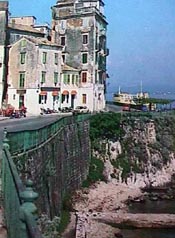
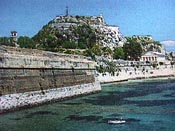

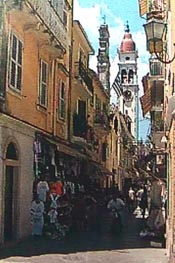
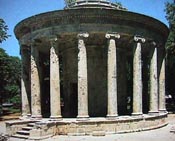
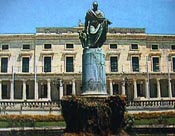

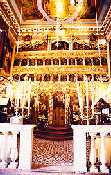
 Built for Sir Fredrick
Adam in 1824 and birthplace of Prince Phillip Duke, of Edinburgh,1921.
Built for Sir Fredrick
Adam in 1824 and birthplace of Prince Phillip Duke, of Edinburgh,1921. 



